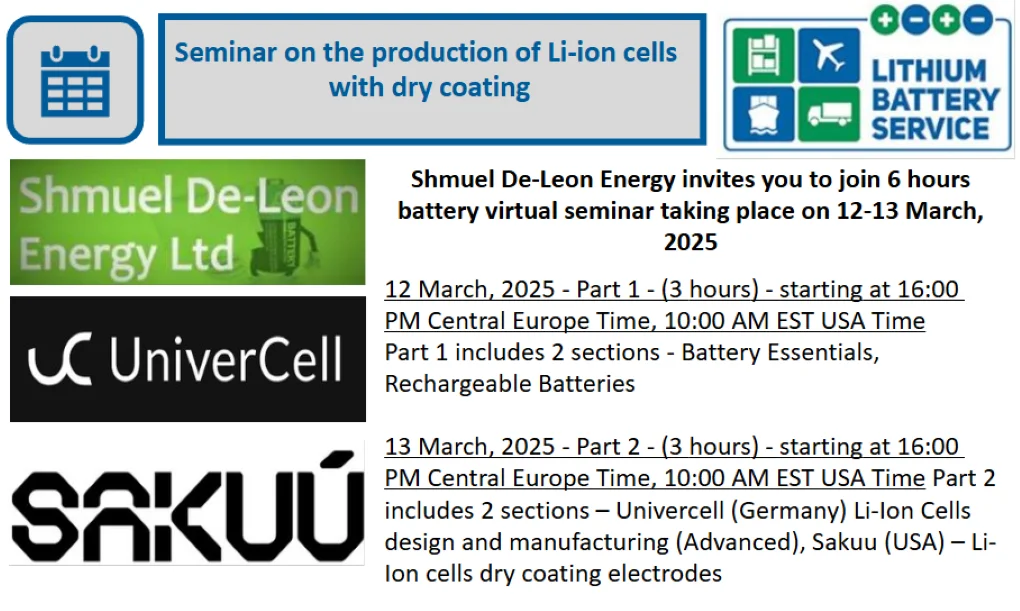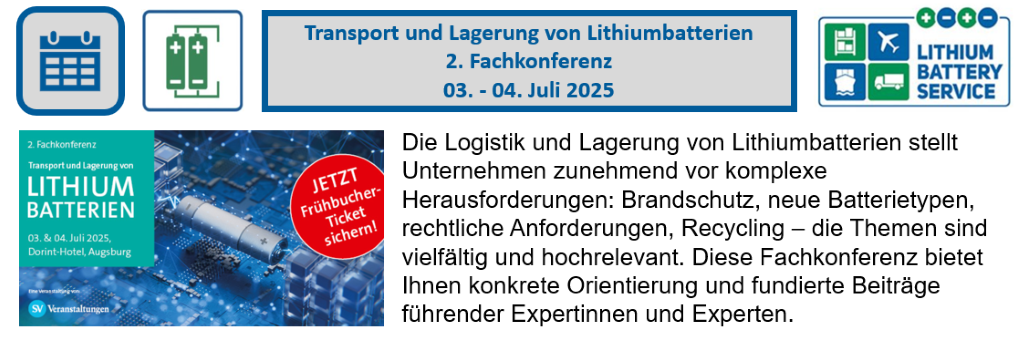Li-Ion Cells Dry Coating Manufacturing Seminar
Shmuel De-Leon Energy invites you to join 6 hours battery virtual seminar taking place on 12-13 March, 2025.

12 March, 2025 - Part 1 - (3 hours) - starting at 16:00 PM Central Europe Time, 10:00 AM EST USA Time
Part 1 includes 2 sections - Battery Essentials, Rechargeable Batteries, 13 March, 2025
Part 2 - (3 hours) - starting at 16:00 PM Central Europe Time, 10:00 AM EST USA Time
Part 2 includes 2 sections – Univercell (Germany) Li-Ion Cells design and manufacturing (Advanced), Sakuu (USA) – Li-Ion cells dry coating electrodes
Training Syllabus:
Battery Essentials – Speaker; Shmuel De-Leon
- Battery History
- The strong need for batteries
- Cells & Battery Packs
- Cells classifications
- Internal cell components
- Anode and cathode structure
- Cell components affecting energy density
- Charge - Discharge operation
- Cells - Button & Coin Cells Shape
- Cells - Hard Case Cylindrical Shape
- Cells - Hard Case Prismatic Shape
- Cells - Prismatic Pouch Shape
- Batteries/Cells Standardization
- Cells - Common Size
- Cells Internal Construction - Bobbin and Spiral Types
- Li-Ion Energy Ver. Power Cell (Flat Plate Construction)
- Cells Internal Construction - Pin Type
- Cells Internal Construction - Flat Plates Type (Stacking)
- Cells Internal Construction – Flat Wound Type
- Cells Internal Construction – Z-Folding
- Cells – Internal Construction Thin Film Type
- Cells - Case Polarity, Seals
- Cell Voltage Definitions
- Internal Resistance/Impedance
- Operating Temperature – What Does it Mean?
- Storage Temperature
- Shelf Life, Cycle Life, Service/Calendar Life
- Factors Affecting Aging and State of Health
- Recommended Battery Storage Conditions
- State of Charge – State of Health
- What is a C-Rate (Apply to Charge and/or Discharge)
- Energy & Power Density
Rechargeable Batteries – Speaker; Shmuel De-Leon
- Rechargeable Lithium Batteries and systems
- Best Performance Cells
- Lithium Rechargeable Cells Electrolyte Types
- Li-Ion Hard Case Cells Advantages, Limitations,
- Hard Case Cylindrical Cells, 18650, 21700
- The Need for Larger Lithium Ion Cylindrical Cell Sizes
- Tesla 21700 Cells
- Hard Case Prismatic Cells
- Hard Case Button Cells
- Li-Ion Pouch Cells Soft Packaging, Advantages, Limitations
- Li-Ion Liquid Electrolyte Pouch Cells
- Ballooned Li-Ion Pouch Cells (Swelling - Gassing)
- Li-Ion Cylindrical Pouch cells
- Jenax Flexible Li-Ion Cells
- Li-Ion Cylindrical Cell with Silicon Nano Structure Anode
- Lithium Iron Phosphate Batteries, Advantages, Limitations
- Why LFP is Highly Safe?
- Lithium Werks LFP Batteries
- LFP as a Replacement to Lead-Acid Batteries
- Li-Ion High Voltage Cells, Advantages, Limitations
- High Power Li-Ion High Voltage Cells
- Solid State Batteries, Advantages, Limitations
- LTO Cells, Advantages, Limitations
- Lithium Dendrite During Low Temperature Charging
- Toshiba LTO Battery - SCiB
- Lithium Sulfur/Metal Rechargeable Cells
- What Prevents the Implementation of Li-Sulfur?
- Oxis Energy Li-S Cells - Sion “Licerion” Li- Metal Cells
- Potential Break- Through Rechargeable Battery Technologies
Univercell (Germany) – Li-Ion Cells Manufacturing – Speaker: Dr. Thomas Yu
Topic 1
• Material choices in battery design Including Electrode optimization for function
• Machining and cell design
• Introduction to battery active material
• Electrodes and battery chemistry
• Separators and electrolytes
Topic 2
• Processes
• Electrode Manufacturing
• Material preparation and mixing
• Roll-to-roll coating
• Drying, calendaring, and other steps in final electrode preparation
• Battery cell assembly
• Pouch
• Cylindrical
• Prismatic
Sakuu (USA) – Li-Ion cells dry coating electrodes – Speaker: Mr. Karl Littau
Abstract: Printing battery components directly from dry powders saves money, time, energy, chemicals, and reduces waste. It also unlocks the capability to print nearly any battery from dry powder formulations
Agenda:
-
Why dry process
- Underlying technological competencies
- Impact on cost
Impact on energy consumption
- Material formulation
- Scaling dry process economically
- Achieving and beating wet electrode specifications
- New innovations enabled by dry printing
- Dry printing of SSB components












